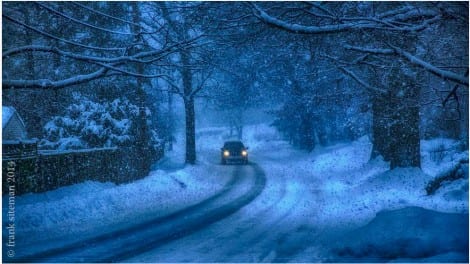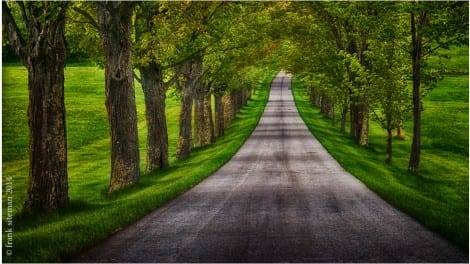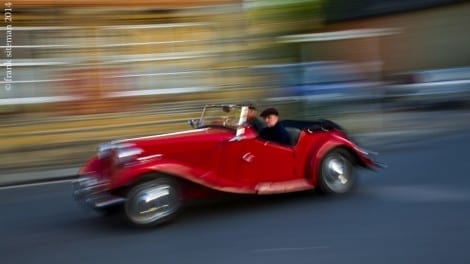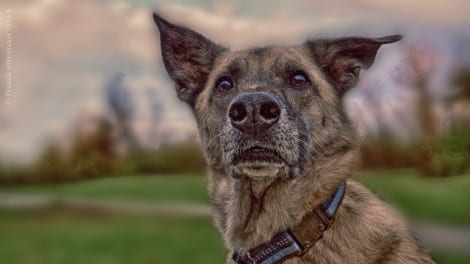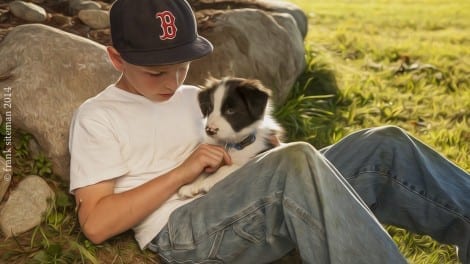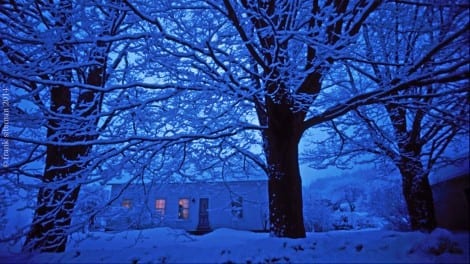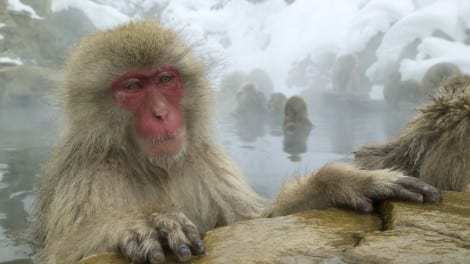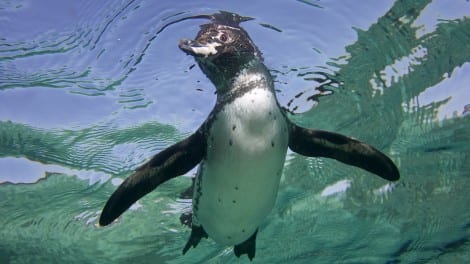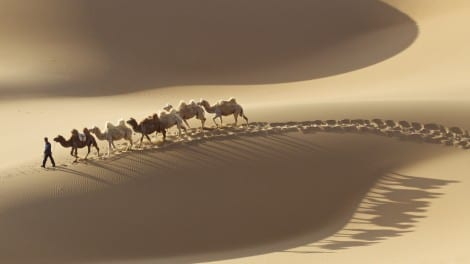DPA Magazine
A vision and a camera
From Frank Siteman/ DPA instructor in Boston To view more of his images please visit http://digitalphotoacademy.com/portfolio/frank-siteman/ Sometimes, quite often as it turns out, great photos are no further from your front door than your front porch. This image is an example of that. No need to travel to a distant land or even get in the car to chase light. I did have to put on a serious coat and go outdoors though, but once there, all I needed was a vision and a camera. To give this image the feeling of the day, I selected a tungsten color balance, which gave the chilling blue color-cast to the snow. The contrast between the on-coming car’s headlamps and that blueish snow make the vehicle pop from the photo. I actually enhanced the lights with NIK software, darkening and warming them, and used another NIK filter to add a cool glow to the overall image. One important technical aspect of shooting in the cold and/or snow is to keep your equipment (and yourself) warm and dry. I made a plastic covering for the camera with an opening just large enough to poke a lens hood through. When not actually shooting, I kept this opening pinned against my body which prevented any snowflakes from landing on either the camera or the lens. IF I’d stayed out longer, I would have kept the camera under my coat, not just for protection, but to keep the battery warm. Shooting in the cold can suck the life out of your battery in a very short time. To address that, I always keep an extra battery in an inside pocket, next to my body, and switch it out with the battery in the camera which is continually chilling as I work. For extended shoots outdoors, I hold a Hothands Hand Warmer outside the camera’s battery compartment. Along with keeping my battery active, I end up having at least one warm hand as well. Another win-win. Camera was Canon 5D, ISO 100, 1/60th sec, 24-105 IS lens at f/5.6, shot at 105mm.
Wondrous light
From Frank Siteman/ DPA instructor in Boston To view more of his images please visit http://digitalphotoacademy.com/portfolio/frank-siteman/ In the quest for great images, I’ve gotten into the habit of taking advantage of the exceptional quality of light in the early morning and late afternoon hours of the day. At this time, the light has a direction and a warmth that only happens when the sun is low on the horizon. I call it chasing light. To this end, I try to find where the beautiful light is falling and nearly never come back without some image that is exceptional just because it was shot in wonderous light. I have a friend from New York City who tells me he never has problems parking in the city. What he does is simple. He finds a parking spot, takes it and then finds something to do around it. Chasing light is like that, and what you find around your spot is often magical. This image was taken late in the afternoon in Bethlehem, NH, found while driving down roads I’d never been on before. It was all discovery. This tree lined driveway (to what will remain a mysterious destination) is a nearly perfect example of both leading lines and the rule of thirds. Everything takes your eye into the depths of this image. The road’s curved sides are nearly mirror images of each other as are the trees themselves. All lines lead to a point 1/3rd down from the top and roughly 1/3rd in from the right.
The Panning effect
From Frank Siteman/ DPA instructor from Boston View more of his images at http://digitalphotoacademy.com/portfolio/frank-siteman/ The technique used to make this photo is called panning. It is a very effective means of conveying motion, and can bring amazing energy to a photo. To obtain images like this, one moves the camera with the subject, keeping the main object in the same place, relative to the edge of the frame. The image of the background sweeps from side to side while the car remains centered….or wherever you’ve placed it in the frame. You can check out the intensity of the blur by simple experimentation, moving the camera at different speeds and/or following subjects which move at different velocities. I like to find a shutter speed which gives me an acceptable and appealing blur and then find an aperture/ISO combination which gives neither an over nor under exposed file, checking your histogram to ensure you are not unnecessarily blowing out important detail. Digital photography makes taking pann shots relatively simple, as it gives you the means to adjust your settings to meet whatever situations you encounter and provide you with an instant preview. In this instance, I was in the small village of Lyme Regis in England and saw this red coupe coming towards me at a relatively slow speed. In order to show it’s motion, I knew from experience that I would be able to get the results I wanted by setting my camera to it’s shutter priority mode and to a 1/15th of a second. If the car had been traveling slower, I might have used a 1/8th sec exposure. This technique is wonderfully effective when shooting runners, people biking, dogs running or even kids playing soccer. The important thing is to find the shutter speed which works for your particular situation and then work around that setting.
Hyper-reality
From Frank Siteman/ DPA instructor in Boston To view more of his images please visit: http://digitalphotoacademy.com/portfolio/frank-siteman/ I don’t think I’ve ever gone out shooting when I haven’t met a dog worthy of having it’s photo taken. One technique which nearly always works is to get down to the dog’s level. This isn’t to say that other unique angles won’t work, but what makes this particular image stand out is that “in your face” factor that you get when looking slightly up at him. I used a relatively short (24mm) lens and came in as close as I could, without altering the situation. In doing so, I accentuated the nose and diminished the relative size of the ears. I felt that this gave a slightly goofy, yet pleasing, feel to the photo. Significant post production work included a NIK HDR application in conjunction with silhouetting the dog and treating the background as a separate entity. I was obviously not going for reality here, but rather a hyper-reality. To that end, I blurred an already out of focus background, while significantly sharpening the dog, except for areas (eyes, muzzle and nose) which wanted to remain crisp. When shooting animals, it’s always helpful to have their person, as well as a helper, around. The owner can get his pet’s attention and your helper can hold a fill card for you. It’s important that the fill card, or reflector, does not alarm the animal however, and I’ve found that with some animals it’s best to use a bright reflector which works from greater distances.
Shallow depth of field
From Frank Siteman/ DPA instructor in Boston To view more of his images please visit : http://digitalphotoacademy.com/portfolio/frank-siteman/ A boy and his dog….. Sure it’s a cliche, but for a good reason. When a photo shows emotion, it’s successful. One difference between a painter and a photographer is that a painter starts with an empty canvas and puts down on it what he or she wants to present. A photographer on the other hand, starts with a full canvas and must eliminate what is distracting or unwanted. In this photo, a relatively long focal length (200mm) was used at a wide aperture (f/2.8) to ensure that there would be a very shallow depth of field. The focus was on the catch-light, or twinkle, in the dog’s eyes. The sun was relatively low in the sky and I positioned the boy and his puppy so that they were illuminated from behind. That produced a rim light that separated the subject from the already out of focus background. It makes the image come alive. I typically use a large reflector, made from a rigid foam insulation board (with an aluminum foil surface) and cover over 50 percent of it’s surface with gold spray paint. This reflector can work from great distances, but must be catching direct rays of sunlight in order to bounce them back. If there is an overcast sky, it will need to be much closer to the subject to work, but the gold warms what would be the reflection of a cool sky. Again, a post processing affect was employed on a separate layer (with a mask) to selectively alter areas of the image and to create a painterly look.
Color balance
From Frank Siteman/ DPA Boston Instructor To view more please visit http://digitalphotoacademy.com/portfolio/frank-siteman/ Siteman says, "This image was made while I was working on a motion picture in woodstock, VT in the late spring. One of my assignments was to shoot footage for the opening sequence and to scout locations. Driving around snow covered muddy roads was a challenge, but finding beauty in the early morning was anything but. I found this house, enveloped by a wet sticky snow, before 5AM and being the only vehicle out at that time… and a stranger to boot, drew attention. It was just what was needed to create a human touch to offset the cold and somewhat forbidding environment. Daylight color balance assured the light from the inside of the home would be very warm and since the sun was hours away from rising, the daylight, like the day itself, remained a very cool blue. This intense contrast of those complimentary colors, as well as the web of snow covered tree limbs, worked well to create an atmosphere of intrigue. This image, with the person peering from behind a curtain, presents an unknown story and in doing so, maintains interest for the viewer. Who’s looking at whom?" Using a 20mm wide angle lens, I was able to hand-hold my camera for a 1/30th sec exposure at f/4, ISO 100.
Capturing the shot
From Josh Anon/Digital Photo Academy instructor in San Francisco To find out more information on Josh please check out: http://digitalphotoacademy.com/portfolio/josh-anon/ "This monkey shot is special to me because it would be hard to get now. Jigokudani park in Japan, the now famous park where the macaques sit in a hot springs, has gotten incredibly crowded to where there are crowds of people there nearly all the time. While it’s still possible to get close to the monkeys, it’s gotten much harder to get a wider shot (45mm on a full-frame camera) like this where you’re close to a monkey so that he’s big in frame and also capturing the environment. The mix of those elements is what makes this shot special. It provides a more intriguing visual story by providing context to the subject, and the monkey’s almost-human face lets us read his peaceful expression. The mist in the background also helps with the context by letting you tell there are other monkeys in the background without drawing your attention to them. Canon EOS 1Ds with Canon EF 24-105 f/4L IS at 45mm. f/16, 1/80 sec, ISO 320."
Beyond Equipment
From Josh Anon/Digital Photo Academy instructor in San Francisco. To find out more information on Josh please check out: http://digitalphotoacademy.com/portfolio/josh-anon/ "It’s easy to become gear-obsessed with photography, but you don’t always need the best and biggest gear to capture a great shot. I was in the Galapagos shooting for a client, and there were a few snorkel excursions where I couldn’t do any shooting for the client. The only personal camera I brought was a Sony RX100, and I had a Nauticam housing and small light so that I could use it while snorkeling. I came across a penguin resting at the surface who let me swim fairly close, and having spent hours underwater in the Falklands trying to capture a penguin underwater, I knew this was a unique opportunity. To make sure the penguin was properly exposed while shooting up against the bright sky, I set my light to act as a fill. Then, I held my breath and dove underwater, coming up below the penguin. I could only take one shot since my strobe was slow to recycle, so I waited until the penguin filled the frame. I managed to get three tries before the penguin swam away, and this was my favorite since he looked at me. Sony RX100 at 28mm in a Nauticam housing with strobe. f/6.3, 1/250 sec, ISO 125."
Understanding light
From Josh Anon/DPA instructor in San Francisco, this shot is a great example of why understanding light is fundamental to photography. To find out more information on Josh please check out: http://digitalphotoacademy.com/portfolio/josh-anon/ "It’s from a desert in China, and we paid the farmer to walk his camels through the dunes. Except we had to pick where he was going to walk for an afternoon shoot in the morning! By thinking about how the sun would move and what shadows we would see, we gave him a rough path, and the light exceeded our guess by having the bright area between the two dunes. When we saw the scene, we had him walk between the two dunes so that the shadows framed the camels. The backlight created a great shadow for the camels along with a rim light around each animal, separating it from the background. I made sure my exposure captured the detail in the shadows, though, so the camels weren’t too dark. A long lens (35mm equivalent around 180mm) let me limit my field of view so that there’s nothing extraneous in the shot. Canon EOS 1D MkIV with Canon EF 100-400 f/4.5-5.6L on a tripod at 120mm. f/8, 1/200 sec, ISO 400"
– Social Coupon Registration –
Our new site is currently experiencing problems with our social coupon sign-up. While we fix the registration we ask if you are enrolling with a Groupon, LivingSocial, Amazon Local, Crowd Cut and CourseHorse or any other coupon voucher, please e-mail us at: Liaison@DigitalPhotoAcademy.com. or call us at 917 597 7053. (Richard in NYC will answer the phone since it is his cell phone.) The information we would like via e-mail or phone call includes: -Your first and last name -Your cell number -If your purchase is for 2 signups, we will also need the e-mail address and cell phone for the guest -Voucher #, (For example, on Groupon Vouchers look for the number just under the bar code, on the upper left section of the voucher.) -The city and date of specific Comp in the Field class you would like to take

